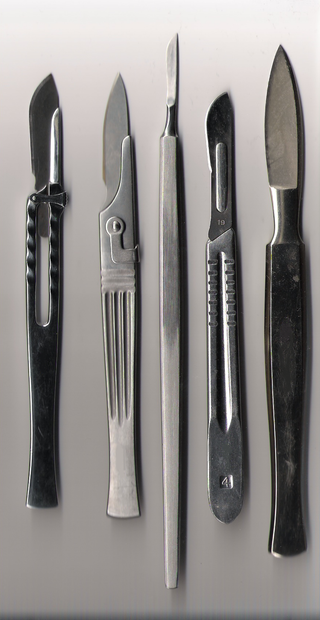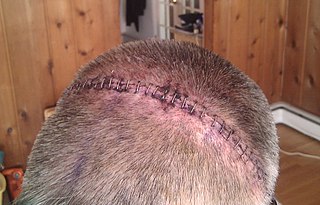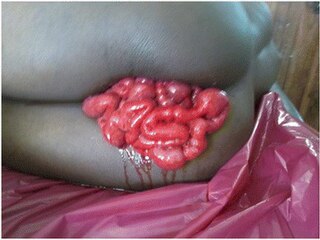Surgical knots (ligatures) are the knots used to bind suture materials together while binding tissue in surgery. They are used in medical and veterinary settings.
Contents

Surgical knots (ligatures) are the knots used to bind suture materials together while binding tissue in surgery. They are used in medical and veterinary settings.


Surgical knots have been used since the first century when they were described by Greek physician Heraklas in a monograph on surgical knots and slings. [1] [2] In the past, the training of astronauts has included the tying of surgical knots. [3]
The effective tying of surgical knots is a critical skill for surgeons since if the knot does not stay intact, the consequences may be serious such as after pulmonary resection, laparoscopic cholecystectomy, and hysterectomy. The primary goal of surgical knot tying is to allow the capacity of a knot (or ligature) to be tightened and remain tight. Ligatures are locked and finished multiple overhand knots. Nevertheless, slipping sometimes happens before the addition of the final knot, particularly during an instrument tie. [4]
The constrictor knot is the knot most used for binding. The constrictor knot closely resembles the clove hitch except the two ends form an overhand knot under the overriding turn. New knots have been described. Other commonly employed knots are surgeon's knot, modified surgeon's knot, single-double other side knot, strangle knot and modified miller's knot. The Surgeon's knot has been a standard ligature but in one study it demonstrated slippage. [4] While the suture is being put in place a knot is used to secure the suture. Tying the knot may be done inside the body or outside the body. Of these two options knot tying inside the body takes some time to learn because the surgeon is required to use laparoscopic instrumentation rather than their fingers to loop the suture. Tying the knot outside the body is simpler for most surgeons because the suture is looped with fingers as in traditional tying. Each knot formed has to be guided through a laparoscopic cannula and made tight with a knot-pusher to create the knot. [5]
In laparoscopic surgery, a stronger braided suture is often preferred if the knot pusher is used because suture fraying is a side effect of this technique. A disadvantage of knot tying being done outside the body is that it often causes more tension and can cause tissue tearing while suturing delicate tissue. [5]
An alternative to the surgical knot is a disposable clip that is placed at the end of the suture to keep stitches secure. A hemoclip is a titanium V-shaped clip with extensions that are squeezed together during application. The clips are available in various sizes and were originally designed to compress vessels for hemostasis. [5]
Tying a surgical knot is done inside the body or outside the body. Learning to tie a surgical knot inside the body is slightly more difficult and has a steeper learning curve. This is because the surgeon uses laparoscopic instruments. Tying the knot outside the body is simpler for most because the suturing is with fingers as in traditional tying. When a surgical knot is formed outside the body it must be drawn into a laparoscopic cannula. Stronger braided suturing thread is preferred because the knot has a tendency to fray as it is slid down the cannula. At the end of the running suture line, clips can be placed across the suture tail. Barbed suture is a knotless surgical suture that has a pattern of barbs on its surface. These barbs lock the suture into the tissue, eliminating the tying of knots. Barbed sutures are typically used in cosmetic and reconstructive surgery. [5] [6] There are concerns that knot tying may be related to glove puncture but a current study demonstrated that instead friction from continuous suturing only left ‘marks’ on the little finger with no glove puncture. [7]
Much effort goes into the training of medical students regarding the surgical skill of knot tying. One method, called “Quiet Eye Training” has shown greater success than more traditional forms of instruction. [8]

The constrictor knot is one of the most effective binding knots. Simple and secure, it is a harsh knot that can be difficult or impossible to untie once tightened. It is made similarly to a clove hitch but with one end passed under the other, forming an overhand knot under a riding turn. The double constrictor knot is an even more robust variation that features two riding turns.

Surgery is a medical specialty that uses manual and/or instrumental techniques to physically reach into a subject's body in order to investigate or treat pathological conditions such as a disease or injury, to alter bodily functions, to improve appearance, or to remove/replace unwanted tissues or foreign bodies. The subject receiving the surgery is typically a person, but can also be a non-human animal.

Laparoscopy is an operation performed in the abdomen or pelvis using small incisions with the aid of a camera. The laparoscope aids diagnosis or therapeutic interventions with a few small cuts in the abdomen.

A surgical instrument is a medical device for performing specific actions or carrying out desired effects during a surgery or operation, such as modifying biological tissue, or to provide access for viewing it. Over time, many different kinds of surgical instruments and tools have been invented. Some surgical instruments are designed for general use in all sorts of surgeries, while others are designed for only certain specialties or specific procedures.

Reconstructive surgery is surgery performed to restore normal appearance and function to body parts malformed by a disease or medical condition.

A laparoscopic adjustable gastric band, commonly called a lap-band, A band, or LAGB, is an inflatable silicone device placed around the top portion of the stomach to treat obesity, intended to decrease food consumption.
Gluteoplasty denotes the plastic surgery and the liposuction procedures for the correction of the congenital, traumatic, and acquired defects and deformities of the buttocks and the anatomy of the gluteal region; and for the aesthetic enhancement of the contour of the buttocks.

A Spigelian is the type of ventral hernia where aponeurotic fascia pushes through a hole in the junction of the linea semilunaris and the arcuate line creating a bulge. It appears in the abdomen lower quadrant between an area of dense fibrous tissue and abdominal wall muscles causing a.
A barbed suture is a type of knotless surgical suture that has barbs on its surface. While suturing tissue, these barbs penetrate inside the tissue and lock them into place, eliminating the need for knots to tie the suture. Conventional sutures rely on a surgeon's ability to tie secure knots; barbed sutures provide a knotless alternative in some surgical situations. Barbed sutures are primarily used in cosmetic surgery.

Surgical staples are specialized staples used in surgery in place of sutures to close skin wounds or connect or remove parts of the bowels or lungs. The use of staples over sutures reduces the local inflammatory response, width of the wound, and time it takes to close.
Tubal reversal, also called tubal sterilization reversal, tubal ligation reversal, or microsurgical tubal reanastomosis, is a surgical procedure that can restore fertility to women after a tubal ligation. By rejoining the separated segments of the fallopian tube, tubal reversal can give women the chance to become pregnant again. In some cases, however, the separated segments cannot actually be reattached to each other. In some cases the remaining segment of tube needs to be re-implanted into the uterus. In other cases, when the end of the tube has been removed, a procedure called a neofimbrioplasty must be performed to recreate a functional end of the tube which can then act like the missing fimbria and retrieve the egg that has been released during ovulation.

A surgical suture, also known as a stitch or stitches, is a medical device used to hold body tissues together and approximate wound edges after an injury or surgery. Application generally involves using a needle with an attached length of thread. There are numerous types of suture which differ by needle shape and size as well as thread material and characteristics. Selection of surgical suture should be determined by the characteristics and location of the wound or the specific body tissues being approximated.
Pyloromyotomy is a surgical procedure in which a portion of the muscle fibers of the pyloric muscle are cut. This is typically done in cases where the contents from the stomach are inappropriately stopped by the pyloric muscle, causing the stomach contents to build up in the stomach and unable to be appropriately digested. The procedure is typically performed in cases of "hypertrophic pyloric stenosis" in young children. In most cases, the procedure can be performed with either an open approach or a laparoscopic approach and the patients typically have good outcomes with minimal complications.
Single-port laparoscopy (SPL) is a recently developed technique in laparoscopic surgery. It is a minimally invasive surgical procedure in which the surgeon operates almost exclusively through a single entry point, typically the patient's navel. Unlike a traditional multi-port laparoscopic approach, SPL leaves only a single small scar.
In medicine, the term cheesewiring or cheesewire effect describes any process in which cells or intercellular matrix are dissected or extruded either by the material being pressed through a taut element, or by the tension of a taut element pulling through tissue. The procedure is typically conducted in a surgical setting.
Liposuction, or simply lipo, is a type of fat-removal procedure used in plastic surgery. Evidence does not support an effect on weight beyond a couple of months and does not appear to affect obesity-related problems. In the United States, liposuction is the most common cosmetic surgery.
An exploratory laparotomy is a general surgical operation where the abdomen is opened and the abdominal organs are examined for injury or disease. It is the standard of care in various blunt and penetrating trauma situations in which there may be life-threatening internal injuries. It is also used in certain diagnostic situations, in which the operation is undertaken in search of a unifying cause for multiple signs and symptoms of disease, and in the staging of some cancers.
A Veress needle or Veres needle is a spring-loaded needle used to create pneumoperitoneum for laparoscopic surgery. Of the three general approaches to laparoscopic access, the Veress needle technique is the oldest and most traditional.
A surgery simulator is computer technology developed to simulate surgical procedures for the purpose of training medical professionals, without the need of a patient, cadaver or animal. The concept goes back to the 1980s with video games, but only in the 1990s with three-dimensional graphics and the 2000s with the use of motion sensors for realistic movements has the technology been able to simulate the real situation. The most common type of surgery taught through this method is laparoscopic surgery, although it has also been used to do a trial run before other kinds of procedures. Cataract surgery and other ophthalmic procedures are also widely taught using surgical simulators.

Vaginal evisceration is an evisceration of the small intestine that occurs through the vagina, typically subsequent to vaginal hysterectomy, and following sexual intercourse after the surgery. It is a surgical emergency.